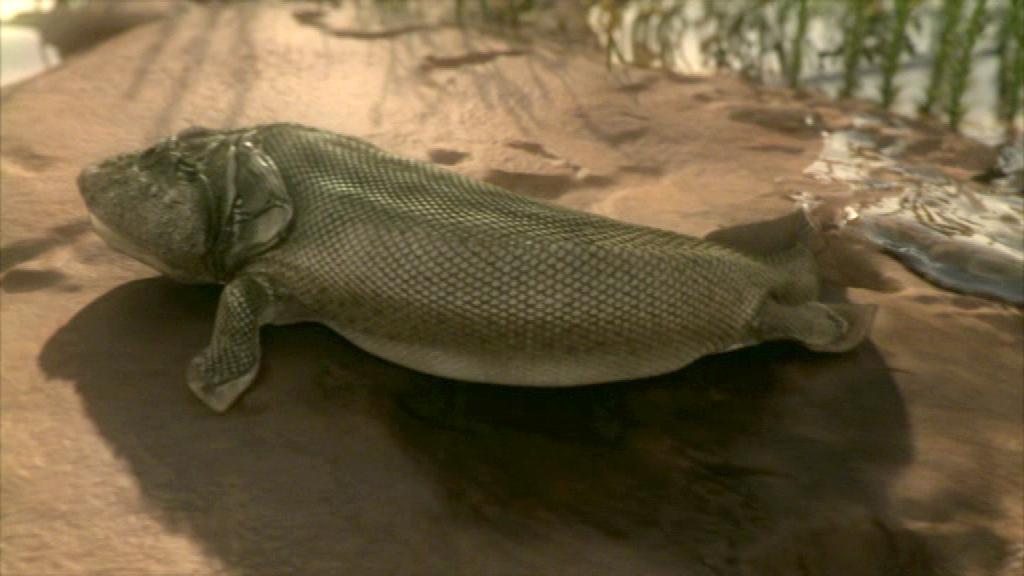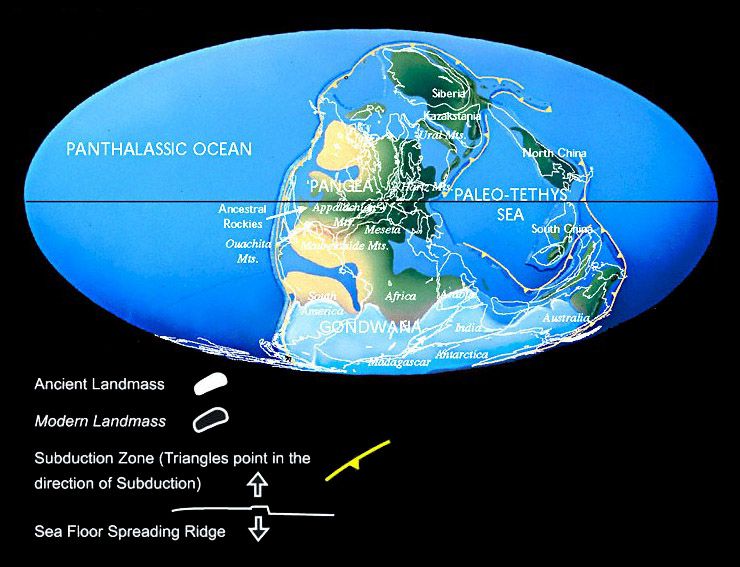335 MILLION YEARS AGO
In places like Scotland, the area was covered at this time with a thick and very tall forest covering much of the continents of the world (which at the time were bunched together in a single landmass). Rising well over 30 metres in height, the forest provided another level of protection from the radiation for the larger animals to make the move onto land not to mention the retention of enough valuable moisture on the ground for any curious invertebrate animals willing to venture out onto dry (?) land.
In addition to this, scientists believe so much oxygen was being pumped out of the forests that the oxygen levels in the atmosphere had risen to around 35 per cent (perhaps the highest the Earth had ever experienced). Fortunately, there was no place on land where the forests could dry out and become flammable enough to burn with great ease. There was literally too much fresh water lying about. As David Attenborough said in his First Life documentary:
"This had a profound effect on animal life.'
Soon the number of animals and plants and their sizes increased, and with it the amount of food available to animals. Conditions were favouring larger animals to make the more onto land and make it their new home. In the insect world, this meant life grew to remarkable sizes. For example, the millipedes we are familiar with today would be more appropriately called metre-pedes as they grew to well over 1.5 metres long. Even dragon flies at this time were literally medium-sized birds skimming across bodies of fresh water on the forest floor.
In fact, the first insects to fly would take place during this time.
315 to 300 MILLION YEARS AGO
With oxygen levels being as high as they were at this time, certain animals learned to lift their body weight above the water, either to escape the predators or to search for food and find new water supplies. The first animals to achieve this remarkable feat occurred as early as 360 million years ago (i.e., during the late Devonian period). Then, over time, the constant lifting of the body would have required extra flesh and bones to develop within the limbs to help make the task easier and more efficient. Fins would still be attached to the ends of the limbs to allow these creatures to swim in water. However, by 315 million years ago, fins were seen as a secondary feature in light of the greater benefits of walking on land on a more regular basis.
As fins were getting smaller, another set of stubby appendages looking like toes and fingers would appear at the ends of the limbs. These would allow greater stability and grip onto wet and flat rock surfaces and to spread the load of the body weight over a larger area for greater comfort.
Among the earliest creatures to have successfully travelled on land for short periods of time is tiktaalik. This is a predator from the Devonian period (suggesting plant-eating animals were already making the move onto land, or perhaps this creature was escaping other predators and was using the insects as a source of food). The creature used its front two limbs to lift and drag its body while the two back limbs provided stability (to avoid falling over to one side or the other when the animal was not in motion on land). By 315 million years ago, the bone in the limbs broke into several crucial segments while still held together by cartilage and muscle to help enable a direct force to be applied onto the ground and so lift the body weight against gravity more easily. Animals with this feature in all four limbs became prolific during the Carboniferous period.

Regular exposure to the air saw some of these creatures develop a primitive lung system to breath the air and extract the oxygen needed to keep the body alive. This would have the benefit of allowing the creatures to survive on land for longer than their competitors. However, the skins of these animals still needed to be moist and so the animals could not live far away from water. The same is true of the eggs produced by these animals — they remained susceptible to drying out unless the eggs are kept in the water.
The first animals to breath the air while still having a reliance on water to keep their skins moist are known as amphibians.
Things progressed very quickly from these amphibians. After a few million years had passed and while the warm conditions prevailed in the early part of the Carboniferous Period, the eggs of the amphibians containing the next generation of offsprings developed a tough outer skin to protect the interior from drying-up and from being easily destroyed by the increasing number of predators appearing on land. Animals which laid eggs of this kind are called Reptiles.
Despite the increasing number of reptiles making their presence known on land, most amphibians continued to enjoy their success to this day so long as fresh water remains on land and is clean enough (something considered hard to find with humans roaming around these days). Some amphibians like the frogs would keep themselves small in size and develop specific skin colours to help camouflage their bodies with the plant life. Other amphibians would develop highly toxic chemicals underneath their brightly coloured skin called alkaloids as an effective chemical deterrent against being eaten alive by the predators. While other amphibians simply relied on their ability to produce many eggs to increase the chances of survival for the species.
290 MILLION YEARS AGO

During a time when great sheets of ice was known to have covered large parts of the supercontinent in the south known as Gondwana land, the first mammal-like reptiles appeared on Earth.
According to the latest genome research, the mammal-like creatures were a little different from other animals in that a rogue and seemingly insignificant "Y-chromosome" suddenly appeared in the male species. Prior to this time, animals had enjoyed a pair of identical "X-chromosomes" with gender determined by environmental factors such as temperature (for example, a low enough temperature in the environment would usually result in the birth of more males, and a warmer temperature would normally create more females). Now, the mammals with this new chromosome made the gender determination independent of environmental factors.
As David Page of the Whitehead Institute in Cambridge, Massachusetts, described the Y-chromosome's function:
"It [the Y-chromosome] said, I will no longer respond to these environmental cues; if I am present, the male pathway will be followed." (1)
So important is this discovery in the genes of mammals that it holds the key to the evolution of the human race.
UPDATE
26 March 2005
A detailed analysis of the X-chromosomes in women compared to the X- and Y-chromosomes of men conducted by Huntington Willard of Duke University in Durham, North Carolina, USA, says women are genetically more complicated than men.
This may seem like stating the obvious when talking to most males since the Y-chromosome is indeed smaller in size than the X-chromosome, meaning there has to be less genes. Therefore, men would have less genetic information stored in the genes than women. Nevertheless, the real question we probably should be asking is, Does this mean that women, being more genetically complicated, are better than men? No. It just means men don't need the extra genetic information to achieve the goals they have to do in life (apart from wanting sex all the time). However, there is a drawback to this increased "genetic efficiency" in men. Principally, men are more genetically susceptible to mutations such as radiation penetrating and damaging or changing the genes (could this be how the Y-chromosome was originally created?) as there is no additional X-chromosome to wrap around and protect the X- and Y-chromosomes. This makes men more easily able to evolve over time if the changes are favourable to the opposite sex.
Furthermore, research conducted by Lars A. Forsberg of Uppsala University in Sweden suggest men are more likely to develop cancer and hence live a shorter life than women because some cells actually lose the Y-chromosome (presumably after sufficient damage has been done to it over time). And among the factors likely to see these Y-chromosomes disappear is during periods when men are smoking. As Forsberg said:
"[The study] demonstrated an association between loss of the Y-chromosome in blood and greater risk for cancer. Out of a large number of factors that were studied, such as age, blood pressure, diabetes, alcohol intake and smoking, we found that loss of the Y-chromosome in a fraction of the blood cells was more common in smokers than in non-smokers."
Details of the research can be found in the online journal Nature Genetics titled "Mosaic loss of chromosome Y in peripheral blood is associated with shorter survival and higher risk of cancer", 28 April 2014.
Women, on the other hand, are better in looking after the core genetic code needed by humans to maintain the core human characteristics by having two X-chromosomes. Understandable considering a number of women like to stay protected (or indoors) and make themselves pretty or do some cooking and cleaning to keep the male partner happy. But in the rare event one X-chromosome gets damaged, there is a better chance for the other chromosome to carry undamaged information, which can aid later in sex through the production of a quality human egg.
What the study has actually shown is that women do indeed use both X-chromosomes. Before the study, scientists thought only one of the X-chromosomes is made inactive and the other X-chromosome provides all the information needed for women (and men) to build the body and perform the tasks needed to survive and hence achieve certain goal(s) during their lifespan. Now scientists have realised active genes are found in both chromosomes.
In the case of men, only the X-chromosome can be relied upon to make men look "human" and able to survive in the same way as women can. But it is the Y-chromosome that help to make men for who they are — men — and to better adapt to an environment through regular mutations.
In other words, this rogue little chromosome helps with building extra muscles, make general changes in appearance to help women become more sexually attracted to men, and increases male sexual drive and sperm production as needed for the human species to survive better and ensure there is sex between the opposite genders (rather than among the same sex).
For women, the extra X-chromosome provides the human species with the necessary in-built checks to ensure the essential genes for defining our species as human remain intact.
Another discovery made in the study is that not all active gene sequences in just one or the other X-chromosome of women are used in men. While men may use some of the same gene sequences as women do in order to be human and perform tasks common to both sexes, women have some 200 to 300 genes in the X-chromosomes used only by women. In other words, there are genes in the X-chromosome uniquely expressed for women relative to men.
In essence, women should be considered as having a different human genome than men. (2)
We can thank the mutation to create the Y-chromosome in men to make a clear and distinct gender difference as needed to increase the likelihood of sex taking place and keep the species surviving for longer.